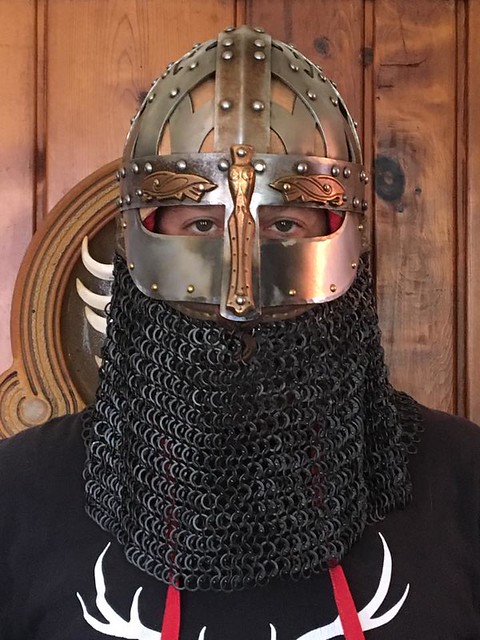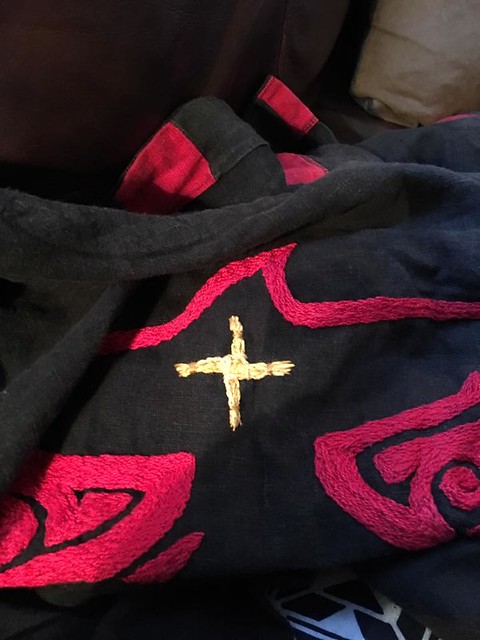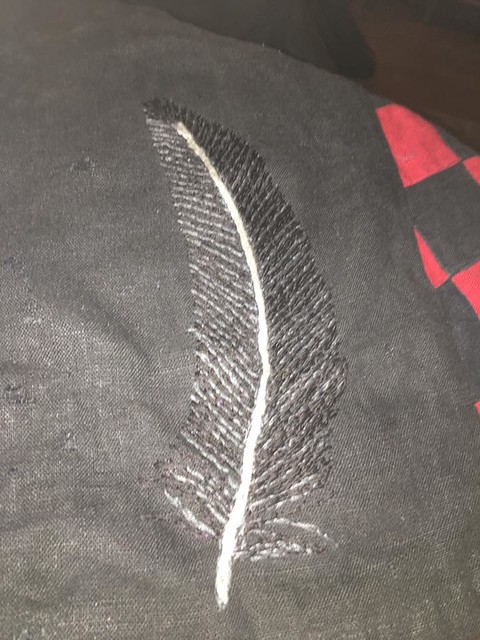The Saga of this ludicrous coat: an Arts and Sciences entry
Posted by Lanea on Sunday, October 14th, 2018
I went to a local SCA event yesterday called “The Wild Hunt.” They had a pair of A&S competitions, one of which intrigued me. “Best fix” was all about a correction or repair, and this coat fit the bill perfectly.
My partner Alherin began using a Valsgärde 6 helmet for tourney fighting in the spring of 2017. The helm is based on a Vendel era boat grave find from Sweden, dating to 660-710 CE 1, and thus later than the material he had previously used to guide decisions about his kit. In general, reproductions of extant early period armor need a great deal of modification to function for SCA combat, and many soldiers or warriors in the ancient and early medieval world had little gear beyond weapons and a helm. Helms like the Valsgärde 6 require the addition of bar grills or some other facial and neck protection, modifications to the size of eye openings, etc. Moreover, the sort of neck, body, leg, arm, and hand armor that functions well for SCA tourney combat was largely developed after the time period he chose for this kit. Alherin cobbled together a kit made up of both modern sports equipment (groin protection, padding, and kydex body armor) and later period items (splinted arms and legs, gauntlets, gorget) that function well and meet SCA safety requirements. Once he had assembled and constructed a new tourney kit, I took on the task of covering the combination of reproduction and modern gear that worked for his fighting style so that he would look as good and as “period” as possible, given the scant evidence of Vendel era armor and textiles available.
Valsgärde 6 has, arguably, the most beautiful helmet of any of the finds in the burial complex. But it has little else2. It is possible that the boat graves were robbed at some point, but whether natural or human intervention is to blame, we had no inhumed garment to use as a basis for this exact helm. I consulted a number of sources and settled on a modified klappenrock to cover his armor and serve as a quasi-heraldic garment so Alherin would be identifiable on the field. The v-neck of such a coat would expose his armor, however, and since we have no doumentable gorget or breast place options to turn to, I decided to use a round neckline with a button attachment instead. Ideally, a wool twill would serve as the primary fabric for a klappenrock, but washabillity, local weather patterns, and Alherin’s own desires took precedence and I used a heavyweight linen tabby instead. I opted to rely on the checkered patchwork of our tribe Preachain as an accent in the gores, along the placket, and on the sleeves. I also opted add embroidery to the back of the coat to please a dear friend3, choosing a design our dear friend Bran painted on one of Alherin’s shields. Knowing that the coat would face a lot of wear, I used a mid-weight pearl cotton for my embroidery fiber and relied on chain stitch for the majority of the work on that back piece.
Before making the coat, I’d studied the history of embroidery for several years and built a class on the subject. I knew what stitches were common in period and what would wear well. I’d done some experimentation with embroidery as a repair method, and I know a number of people who are much better at drawing than I am, so I hoped to convince at least a few of them to sketch designs for me as need required.

(Photo by Krystal Smith)
When Alherin stepped onto the field in this coat the first few times, I knew that friends would make a game of trying to break the button off in combat (none has succeeded thus far) and that the black and red colors our tribe relies on would fade with washing and the sun. I also knew that embroidery developed out of repair techniques like pattern darning, and was ready to do some repair now and then.
What I did not know was that his new splinted legs would eat the coat from the inside. He wore it for the first time in Spring Crown of 2017 and it took some minor damage, so I made some minor repairs. The repair process hasn’t stopped since. After several repairs were complete, he asked me to add a small Brigid’s Cross to the back piece to symbolize my own heraldry. Ever other stitch I’ve added post-debut has been a decorative repair.
I may have created a monster. I have definitely created an amazing testing ground. The cotton embroidery has fared far better than the silk, as to be expected. At least one of the detergents we’ve used has caused some very sad fading and dulling to the silk repair embroideries.
1 John Ljungkvist, Uppsala University: The development and chronology of the Valsgärde cemetery” table 1a-b. https://www.researchgate.net/publication/278009526_The_development_and_chronology_of_the_Valsgarde_cemetery
2 Maja Wikborg: “The absence of human remains in Valsgärde cemetery. Natural process or ritual phenomena?”
3 Ursus does not want anyone to have solid black, red, or white surcoats because it causes lens flare and color distortion in processing. We listen to Ursus’s guidelines because we adore him.
Filed in Celtic,embroidery,quilting,sewing | One response so far




Kirstenon 23 Oct 2018 at 8:04 pm 1You could say that the fading of cloth is to please Ursus also!
I know I don’t understand the structure of SCA. Our local unit was 5 people or so, and I was too tired to pursue it. What is Preachain? Aside from your clan.
And great poetry, again.